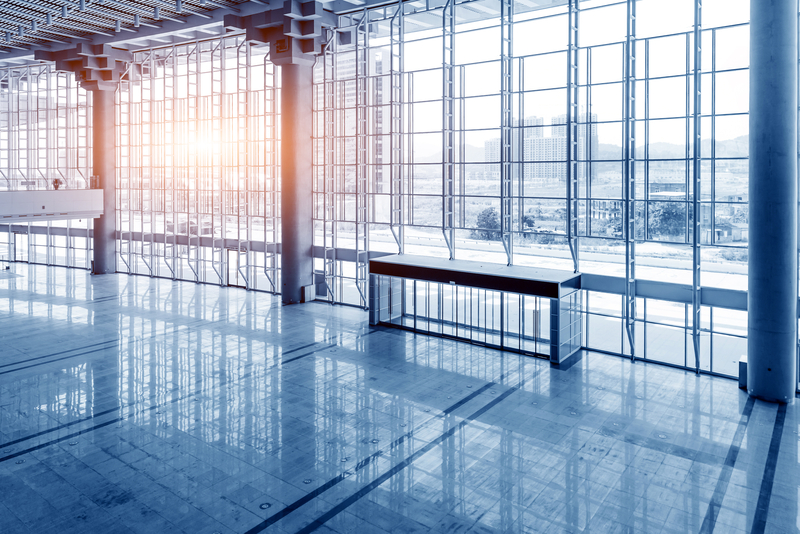
Curtain walls are non-structural walls constructed with aluminum frames and filled with materials such as glass, metal or stone panels and firmly attached to buildings' strong frame to serve various purposes beyond aesthetics and maximizing natural light and views.
You’ll mostly see this system in highrise buildings. Curtain walls can be listed based on the assembly method, fill in material, performance and aesthetics.
Let's break it down for you so you know what to choose when you are ready to fit your building with these magnificent and efficient systems.

Curtain walls can be designed with a wide range of materials and accommodate many different shapes and designs. We are talking glass, metal panels, stone veneers and terracotta.
Glass, of course, is a popular choice and for good reason. It offers benefits such as lightweightness, modernistic grandeur and versatility including tinted, laminated, and reflective options depending on the desired transparency and solar control.
That said, glass in-fills are not as durable as metallic alternatives. We are talking high levels of impact and weather resistance. Metal in fills may also be perforated for enhanced ventilation and finished in different colors and shine.
On the other hand, stone veneers have a vibe. We are talking about classic and luxurious aesthetics often paired with traditional style architectures. But they tend to be the heaviest option. Terracotta materials are just clay, albeit one baked at high temperatures. So, you have fire resistance going on for you. They also come in intricate designs, and colors.
Another way to look at curtain wall systems depends on the way they are installed on site. If you assemble the system on-site piece by piece, you design a stick-built curtain wall system.
The installation requires time and specialized skills but it offers great flexibility and customization options for complex and irregular shaped buildings. The first pieces to be installed are aluminum frames.
We are talking transoms and mullions aka horizontal and vertical rails. Once the frames are erect, you can add your in-fill materials and other components. The stick-built designs require lower initial cost and are suitable for smaller projects.
On the other hand, a unitized curtain wall system is pre-assembled in factory-controlled conditions and shipped for installation as is. This completely reduces the installation time and overall duration of the construction project.
However unitized systems require standardized designs as you won’t be able to do much customization on the unit once it’s completed in the factory.
The advantages and disadvantages of these two types of curtain wall systems can be summarized as follows.
Advantages of stick-built design
● Highly customizable
● Lower initial cost
● Suitable for smaller projects
Disadvantages of stick-built design
● Longer installation time
● Requires skilled labor
● Less weather-tight
● You may need to clean up afterwards to get rid of wastes
Advantages of unitized design
● Shorter installation time
● More watertight
● More efficient
● Little cleanup required
● Lower ongoing maintenance
● Higher quality control
Disadvantages of unitized design
● Less flexible
● Limited customization options
● May require more initial investment
● Repairing/replacing individual pieces can be a pain
● Not suitable for small projects
Another way to look at curtain wall systems depends on what they are engineered for. We are talking hurricane resistant systems comprising impact proof glass, strong frames and anchoring systems for people in coastal and inland areas. Another option involves adding features to enable solar control.
We are talking about tinted or reflective glass coatings, external shading devices, or frit patterns such as ceramic dots embedded in the glass. Additionally curtain wall systems can be engineered for thermal insulation using double or triple glazed panels, insulated framing materials, and thermal breaks.
Lastly, it would be remiss if we didn't mention that curtain walls can be categorized based on the aesthetics such as a curved panorama, sloped glazing system or a rainscreen.
For example, glass can be curved such that the system extends rooms past the building's main footprint resulting in more interior space, natural light and views. Furthermore, shades can be engineered to deploy based on the path of the sun and reduce heat gain.
Bending glass, twisting panels and adding shades and water-resistant membrane will surely cost you extra but the views and extra insulation and moisture resistance benefits may be worth it.
Of course, some unconventional designs also use less aluminum than others. For example, a circadian curtain wall uses way less aluminum per square foot compared to traditional flat panel systems. You can learn all this and more by speaking with our curtain wall experts.
Whether you are looking for a standard design or have something in mind to turn your building into a whole vibe then we will be glad to indulge you. We extrude aluminum profiles for various uses including curtain walls, windows and door systems at reasonable prices.
Don't worry about your requirements; we are here to help. Contact us today to speak with an expert.
Shishan Production Base
Nonferrous Metal Industrial Park, Xiaotang, Shishan Town, Nanhai District, Foshan City, Guangdong Province
Gaobian production base
Gaobian Zhangbian Industrial Zone, Dali Guangyun Road, Nanhai District, Foshan City, Guangdong Province
Company summary: + 86-757-85558828
Fax: + 86-757-85550238